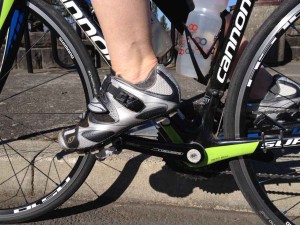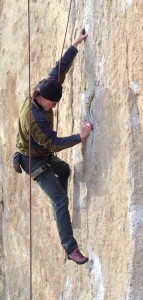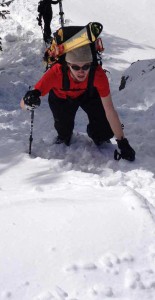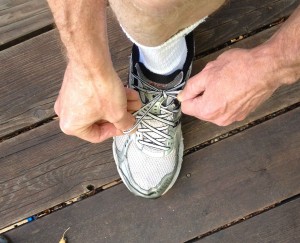 John Ratey’s 2008 book “Spark” aims to interest us in an ancient way of enrichment and well-being – a way so old that our ancestors have been doing it for millions of years (p. 63, Kindle Loc. 877). It’s free, equally available to the privileged and underprivileged, can’t be patented, and it’s guaranteed to get your heart pumping like a summertime blockbuster thriller. It also promotes mind-body integration and can help deepen your awareness as an experiencing, embodied being.
John Ratey’s 2008 book “Spark” aims to interest us in an ancient way of enrichment and well-being – a way so old that our ancestors have been doing it for millions of years (p. 63, Kindle Loc. 877). It’s free, equally available to the privileged and underprivileged, can’t be patented, and it’s guaranteed to get your heart pumping like a summertime blockbuster thriller. It also promotes mind-body integration and can help deepen your awareness as an experiencing, embodied being.
“Spark” begins with a statement that sets a context for the rest of the book: “Our culture treats the mind and body as if they are separate entities, and I want to reconnect the two.” (Ratey, 2008, p. 4, Kindle Loc. 31) I’m a mind-body therapist by training, so Dr. John had me hooked from his integrative goal statement onward. I’ve appreciated his other books on ADHD and neuroanatomy, so I was eager to read what Ratey was proposing.
Dr. Ratey, a clinical professor of psychiatry at Harvard Medical School, reminds us that we were born to move. Our bodies are built for the hard work of food gathering, hunting and surviving predation – and the complex learning necessary for success at these life-sustaining activities. According to Dr. Ratey, “physical activity is crucial to the way we think and feel.” (Ratey, 2008, p. 4, Kindle Loc. 42) He cites research that demonstrates the link between movement/exercise, and creation of the building blocks of learning in the brain – some of the very things that affect mood and thinking.
Consider – I got back from running 30 minutes ago and took some time to cool down. I’m sitting at my desk now, tapping on my keyboard. I’m aware of feeling different from before I ran. My mind is sharper, I feel more alert, and my familiar mid-afternoon dullness is absent. I feel oddly “better” and I like it. I’m ready and eager to engage.
 So, what’s going on in my body and brain? According to Ratey, the old explanation – endorphins and the “runner’s high” isn’t the whole story. According to research cited in “Spark”, a cascade of biochemical regulatory factors produced during exercise (FGF-2, IGF-1, VEGF) work together with another factor in the brain (BDNF) to initiate neurogenesis – the creation of new neurons, and to cause existing neurons to develop new dendrites. Aerobic exercise initiates a follow-on effect of making nerve endings “bushier” and “leafier”, making more receptors available for new connections (Ratey, 2008, pp 48-52, Kindle Loc. 662-762). It also increases production of neurotransmitters like serotonin, norepinephrine and dopamine. Exercise, according to Ratey, prepares ideal conditions for learning in the brain (Ratey, 2008, pp 62-67, Kindle Loc. 875-940).
So, what’s going on in my body and brain? According to Ratey, the old explanation – endorphins and the “runner’s high” isn’t the whole story. According to research cited in “Spark”, a cascade of biochemical regulatory factors produced during exercise (FGF-2, IGF-1, VEGF) work together with another factor in the brain (BDNF) to initiate neurogenesis – the creation of new neurons, and to cause existing neurons to develop new dendrites. Aerobic exercise initiates a follow-on effect of making nerve endings “bushier” and “leafier”, making more receptors available for new connections (Ratey, 2008, pp 48-52, Kindle Loc. 662-762). It also increases production of neurotransmitters like serotonin, norepinephrine and dopamine. Exercise, according to Ratey, prepares ideal conditions for learning in the brain (Ratey, 2008, pp 62-67, Kindle Loc. 875-940).
Ratey describes in detail the biological link between movement, thought and emotions. I’m interested in using that link for the learning that’s part of personal growth – my own and my clients’. Learning, changing, and growing is no easy thing, so it makes sense to engage additional support. Let’s look at a way to stack the deck in your favor.
As the story in “Spark” unfolds, Dr. Ratey takes the research findings on brain science and learning into the consideration of stress. Who doesn’t wish at some time for less stress? Ratey considers the role that stress plays in creating resilience and cautions that we can’t see stress as simply bad or good if we want to understand the vitalizing role it plays. Our bodies are designed for stress – and recovery. Think about the best way to make muscles stronger and increase resilience; stress the muscle by making it work, followed by recovery. Dr. Ratey points out that a variety of body systems, including our nervous system, benefit from the same kinds of cycles of stress and recovery (Ratey, 2008, p. 59, Kindle Loc. 825).
Dr. Ratey takes us through the cascade of biochemical responses that the body mobilizes during stress, including the body’s neutralizing countermeasures and cleanup processes that he calls a “janitorial service” (Ratey, 2008, p. 78, Kindle Loc. 281). Cleanup and janitorial processes? Yes. Since stress is designed into our bodies, we have the means to cleanup and recover from stress to become stronger and build resilience. Those cellular countermeasures are triggered in part by exercise and movement.
The janitorial aspect of the stress cleanup response triggered by exercise is long and detailed. The story gets interesting when Ratey considers long-term chronic stress and the damage that it causes to the brain. He cites research that shows exercise being significantly effective in reversing some of the long-term effects of neural degeneration due to chronic stress (Ratey, 2008, pp 72-78, Kindle Loc. 1019-1095). It seems that our brains can indeed recover from degeneration caused by chronic stress, and that exercise is a key ingredient.
Stress and recovery make us stronger and more resilient at the cellular level and contribute to resilience in our lived experience. In Dr. Ratey’s words, “The paradox is that our wonderful ability to adapt and grow doesn’t happen without stress” (Ratey, 2008, p. 74, Kindle Loc. 1040). Both body and mind, he emphasizes, are built for stress – and recovery. And, the key takeaway – exercise facilitates recovery.
 So, is it any wonder that I felt good after my run? Leafier dendrites, stress cleanup, janitorial service – could it be that they all combine to give me this subjective experience that I call “better” and “more alert”? Subjective experience is a place where black and white answers are difficult to nail down. But while the science of subjective experience has ambiguity, I have no doubt that my “better” and “more alert” feeling adds to my positive outlook and upward spiral.
So, is it any wonder that I felt good after my run? Leafier dendrites, stress cleanup, janitorial service – could it be that they all combine to give me this subjective experience that I call “better” and “more alert”? Subjective experience is a place where black and white answers are difficult to nail down. But while the science of subjective experience has ambiguity, I have no doubt that my “better” and “more alert” feeling adds to my positive outlook and upward spiral.
Dr. Ratey focuses the final chapters of “Spark” on some of the emotional and mental maladies that afflict us. He has a strong and encouraging story to tell about the beneficial effects of aerobic exercise and movement on outcomes and lived experience, and on the underlying neuroanatomy that supports well-being. The same cascade of biochemical factors that are beneficial for stress cleanup are helpful here as well – BDNF, VEGF, IGF-1, FGF-2, etc. along with increases in serotonin, norepinephrine and dopamine. Ratey cites study after study showing consistent beneficial effects for these maladies through aerobic exercise. (Ratey, 2008, pp 124-132, 135-136, Kindle Loc. 1918-1938, 1762-1879)
I’m impressed by the degree of caring and compassion that Dr. Ratey conveys in these chapters. His story isn’t just a synthesis of scientific research – he seems to compassionately understand the suffering that he’s addressing. When writing about this, it’s easy to get caught up in the science or in the disorders and forget that the topic is really about human suffering and the reality of persons living difficult lives. Compassion can easily be lost and suffering persons reduced to objects of study. So I’m touched and encouraged to read Ratey advocating to help sufferers genuinely thrive and go for recovery/healing that’s beyond the clinical threshold definitions of illness (Ratey, 2008, p 185-189, Kindle Loc. 2636-2696).
I feel a sense of optimism in reading “Spark” and also a pull toward being realistic about getting the world motivated to exercise. Let’s face it, aerobic exercise won’t be everyone’s cup of tea – Dr. Ratey points out that some exercise studies have a 50% drop out rate (Ratey, 2008, p. 259, Kindle Loc. 3674). Lifestyle changes on the scale required to accommodate regular aerobic exercise require that motivation be addressed.
Motivation to start something new can be a tricky thing. As a writer on motivation (Ratey, 2001), Ratey is no stranger to motivation issues. He advises, “The key is to attack the business of starting as a challenge in itself.” (Ratey, 2008, p. 250, Kindle Loc. 3552) I’m reminded that the skill of getting started with something new is different from the skill of continuing an established habit. For some of us, getting started will be more of a challenge than the actual exercise.
Ratey adds further motivational fuel by sharing his reasons for writing “Spark”:
“I’ve trumpeted the astounding impact of aerobic activity on the brain in the hope that if you understand what’s actually going on up there when you go for a run, you’ll develop a genuine motivation to lace up your sneakers every day. Or you’ll go for a swim or hop on your bike or do whatever you enjoy doing to work up a sweat. I want nothing less than to get you hooked.” (p. 245, Kindle Loc. 3645)
 If Dr. Ratey’s “astounding impact” isn’t motivating enough, then perhaps encouragement could come from existential thinkers. Viktor Frankl (1984) comes to mind from “Man’s Search for Meaning”:
If Dr. Ratey’s “astounding impact” isn’t motivating enough, then perhaps encouragement could come from existential thinkers. Viktor Frankl (1984) comes to mind from “Man’s Search for Meaning”:
“Everything can be taken from a man but one thing: the last of the human freedoms—to choose one’s attitude in any given set of circumstances, to choose one’s own way.” (p. 75)
Could that “one’s own way” include choosing to care for self through physical exertion?
If aerobic exercise evokes a sense of suffering, then it may help your motivation to recall Frankl’s advice that, “…suffering ceases to be suffering at the moment it finds a meaning…” (Frankl, 1984, p. 117). Could the meaning of running lie in the resilience and mind-body well-being that Dr. Ratey describes? Or in exercising good faith with oneself in a path that includes physical exertion? I do sometimes think about both of those when my motivation for yet another wet December run goes dry.
Still, finding motivation or changing self-defeating patterns can be a complicated and tricky thing that necessitates deeper understanding in order to change. It may be that a course of counseling therapy with life-changing results is called for. If so, please take heart – you’re surrounded by a wealth of resources for that kind of work.
Ratey certainly isn’t proposing a quick fix or a passive cure. There are no pills here, or an app that needs just a few swipes and taps. Instead, he’s encouraging the hard work of moving, breathing hard, and sweating. It’s old-school stuff, a return to the roots of what it has meant to be human. It’s also the opposite of passivity or apathy. I was already hooked on an active lifestyle when I read “Spark” so the motivation to sweat wasn’t a big concern for me. Still, since reading “Spark” I often reflect on what Dr. Ratey shared about movement and exercise. I find encouragement from Ratey’s thoughts when I lace up my shoes or click into my pedals to move, breathe, cleanup from stress, and to trigger neurogenesis.
I wonder – how does Ratey’s premise sit with you? Do you already have an active lifestyle? Or, are you wanting to become more active? If so, does the task of getting started stand in your way? Is there something that would support you in putting your wishes into motion and movement? Does additional motivation help? I’d love to hear from you in the comments section or in a reply. Please feel welcomed to share your own story.
References and further reading:
Frankl, Viktor. (1984). Man’s Search for Meaning, Third Edition. New York, NY: Simon and Schuster.
Ratey, John J. M.D. (2008). Spark [Kindle Edition]. New York: Little, Brown.
Ratey, John J. M.D. & Hallowell, Edward D. M.D. (2005). Delivered From Distraction. New York: Anchor.


